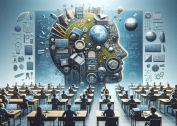Curious about how remote education is reshaping the learning landscape? This detailed guide explores key trends in remote learning, digital classrooms, and the role of technology in education—packed with insights for anyone wanting to stay ahead in a rapidly shifting world.
The Rise of Remote Learning in Education
Online education has transformed expectations for learners of all ages. During the past decade, advances in high-speed internet and digital devices have fueled a remarkable shift from traditional classrooms to remote learning environments. Many parents, students, and professionals have turned to online courses and flexible schedules to keep up with educational demands. These trends have reinforced the idea that geography is no longer a barrier to quality instruction. Remote education allows for broad access; innovative platforms connect students with a global pool of experts.
Emerging technologies such as video conferencing, collaborative software, and real-time chat tools continue to drive the rise of remote learning. These innovations help replicate classroom experiences, offering structured lesson plans, teacher interaction, and direct feedback. Synchronous and asynchronous learning models give students the flexibility to engage at their own pace while also having opportunities for live participation. This accessibility and variety support both personal and professional growth, indicating that remote education is here to stay.
Some critics have raised concerns about engagement and motivation in online education settings. Yet, research suggests that remote education can foster independent learning skills and self-motivation, preparing students for lifelong learning. Additionally, remote curricula allow for personalized pacing and the frequent use of educational technology, meeting a wide variety of learning needs. For many families, the affordability and accessibility of online classes continue to make them a practical choice (Source: https://ies.ed.gov/ncee/edlabs/regions/west/relwestFiles/pdf/REL_2022129.pdf).
Digital Classrooms and Interactive Platforms
Digital classrooms blend traditional instruction with interactive technologies. Tools such as virtual whiteboards and cloud-based assignment sharing help teachers create engaging and dynamic lessons. Many schools and colleges now integrate learning management systems, allowing for seamless assignment collection and automated grading. Personalized dashboards let students track their own progress, which can encourage goal setting and persistent effort. Through these systems, educators deliver real-time feedback and support more than ever before.
Features like discussion boards and collaborative projects encourage peer-to-peer learning and create a sense of community, even at a distance. Students from geographically diverse backgrounds can engage in group work, sharing unique perspectives and fostering cross-cultural understanding. Research has shown that group-oriented assignments in digital classrooms help develop communication and problem-solving skills, which are crucial for both academic and professional success (Source: https://www.edutopia.org/article/leveraging-discussion-boards).
The use of analytics in digital classrooms is rising. Teachers and institutions monitor engagement and performance through dashboards that highlight individual progress. This data-driven approach helps educators quickly identify areas needing attention. It also supports adaptive learning—digital platforms adjust content automatically based on a student’s strengths or struggles. In this way, interactive education platforms improve learning outcomes for diverse student populations.
Evolving Technologies in Remote Education
Technology drives innovation in remote learning. Artificial intelligence (AI) tools, adaptive quizzes, and multimedia simulations make lessons more compelling and suited to various learning preferences. AI-powered tutoring services can assess a student’s progress in real time, suggesting helpful resources and practice exercises. Meanwhile, simulations and interactive games are used to explain complex topics in STEM, humanities, and language studies. As a result, students enjoy more engaging, hands-on learning experiences online than ever before.
Virtual reality (VR) and augmented reality (AR) are also making their way into education. Imagine exploring ancient ruins, chemical reactions, or microscopic cells through a VR headset from your living room. These immersive technologies support experiential learning—students engage with abstract ideas in tangible, memorable ways (Source: https://www.edweek.org/technology/how-do-ar-and-vr-fit-into-education/2021/09). Smart automation, voice assistants, and personalized recommendations further streamline both teaching and learning.
Mobile learning platforms have made education even more accessible. In many parts of the world, students rely on smartphones or tablets rather than desktop computers. Educational apps and responsive course websites ensure learning can happen anywhere—on a commute, while traveling, or after work. This flexibility supports students who juggle multiple priorities and is increasingly popular among adult learners returning to education later in life.
Barriers to Access and Equity in Remote Learning
Despite remote education’s potential, not everyone benefits equally. A significant digital divide remains for students without reliable internet or access to devices. In many low-income or rural communities, these barriers severely limit educational opportunities. Libraries and community centers have stepped up to help, providing internet hotspots or lending laptops. However, sustainable, equitable solutions require investment and coordinated efforts from schools, governments, and the tech sector (Source: https://www.brookings.edu/articles/the-pandemic-has-shown-that-remote-learning-is-here-to-stay/).
Language barriers, disabilities, and homes without supportive learning environments can also affect remote education outcomes. Technology providers and education leaders are adapting platforms with features like closed captioning, accessibility options, and curriculum translation tools. By acknowledging and addressing these challenges, remote education moves toward greater inclusivity. The conversation around equity—who gets access and what supports they have—remains pivotal in shaping the future of remote learning.
Professional development for educators is equally critical. Teachers need training in remote education tools, digital classroom management, and inclusive teaching strategies. Effective programs can help close the gap between technologically advanced schools and those with fewer resources. Cross-sector partnerships and public initiatives increasingly offer educators the support required for successful digital transformation (Source: https://digitalpromise.org/2020/09/10/educators-need-more-support-for-effective-remote-instruction/).
Remote Assessment Methods and Student Motivation
Remote education includes new approaches to measuring progress. Traditional exams are being replaced or supplemented by project-based assessments, e-portfolios, and online quizzes. These formats encourage students to show their understanding in creative, meaningful ways. Digital tools let educators assess participation, collaboration, and the application of concepts over time, meaning assessment becomes part of the learning process rather than a separate event.
One challenge is maintaining motivation in self-paced courses. Without regular face-to-face interaction, some students may struggle to stay focused. Programs that incorporate regular check-ins, peer interactions, and feedback systems can increase engagement. Additionally, gamification—using badges, points, or leaderboards—motivates learners by making progress visible and rewarding consistent effort (Source: https://www.edutopia.org/article/gamification-classroom).
Self-regulated learning, where students set goals and monitor progress, is a key skill fostered by remote education. Research suggests that building and supporting these skills early on is crucial for successful outcomes in virtual programs. Institutions that provide counseling, mentoring, and digital literacy support help learners transition confidently to self-directed education. As technology improves, these supports become more embedded in virtual learning systems.
The Future of Remote Education and Societal Impacts
The future of remote education is dynamic. Expectations and preferences evolve as students and teachers gain experience with digital tools. Hybrid learning models—combining remote instruction with in-person elements—are on the rise in schools and workplaces. This blended approach increases flexibility and serves a wider variety of learning styles and schedules. It also holds promise for closing gaps in access and engagement.
Remote education could shift social dynamics around schooling and work. For instance, families may choose virtual schooling to support unique health, mobility, or career needs. Adults might pursue new certificates or degrees while continuing to work, opening doors to career advancement or transitions. Increased flexibility and affordability also support lifelong education, vital in a rapidly changing job market.
Societal acceptance of remote education is growing. Many employers now recognize and value online degrees, certificates, and micro-credentials. Public policy, too, is adapting—regulating digital learning, streamlining credit transfers, and ensuring student protections. As these frameworks develop, remote education will likely reach new heights in accessibility, quality, and outcomes (Source: https://www.rand.org/pubs/research_reports/RR4436.html).
References
1. National Center for Education Evaluation. (2022). Distance Learning in K–12 Education. Retrieved from https://ies.ed.gov/ncee/edlabs/regions/west/relwestFiles/pdf/REL_2022129.pdf
2. Edutopia. (2022). Leveraging Discussion Boards for Deeper Learning. Retrieved from https://www.edutopia.org/article/leveraging-discussion-boards
3. Education Week. (2021). How Do AR and VR Fit Into Education. Retrieved from https://www.edweek.org/technology/how-do-ar-and-vr-fit-into-education/2021/09
4. Brookings Institution. (2022). The pandemic has shown that remote learning is here to stay. Retrieved from https://www.brookings.edu/articles/the-pandemic-has-shown-that-remote-learning-is-here-to-stay/
5. Digital Promise. (2020). Educators Need More Support for Effective Remote Instruction. Retrieved from https://digitalpromise.org/2020/09/10/educators-need-more-support-for-effective-remote-instruction/
6. Edutopia. (2021). Gamification in the Classroom. Retrieved from https://www.edutopia.org/article/gamification-classroom









